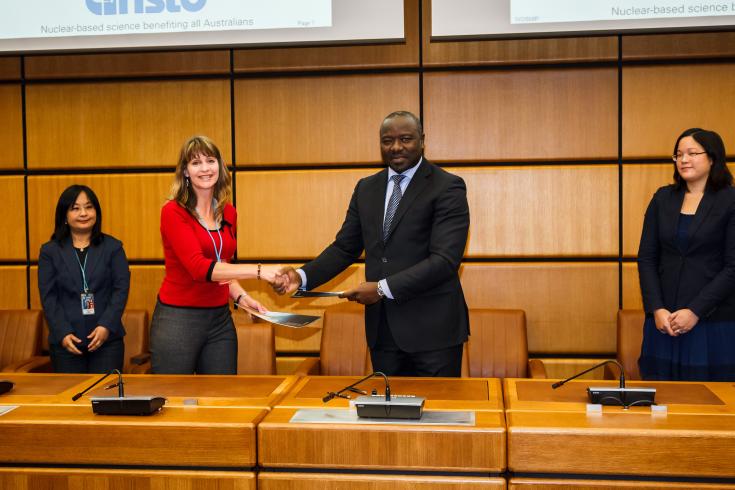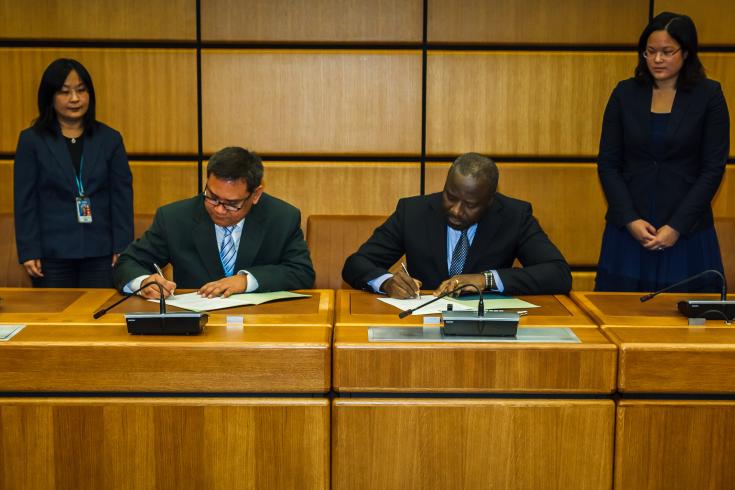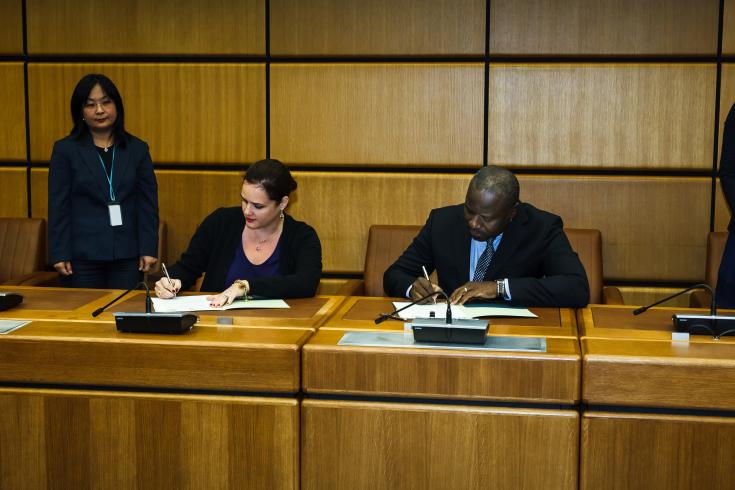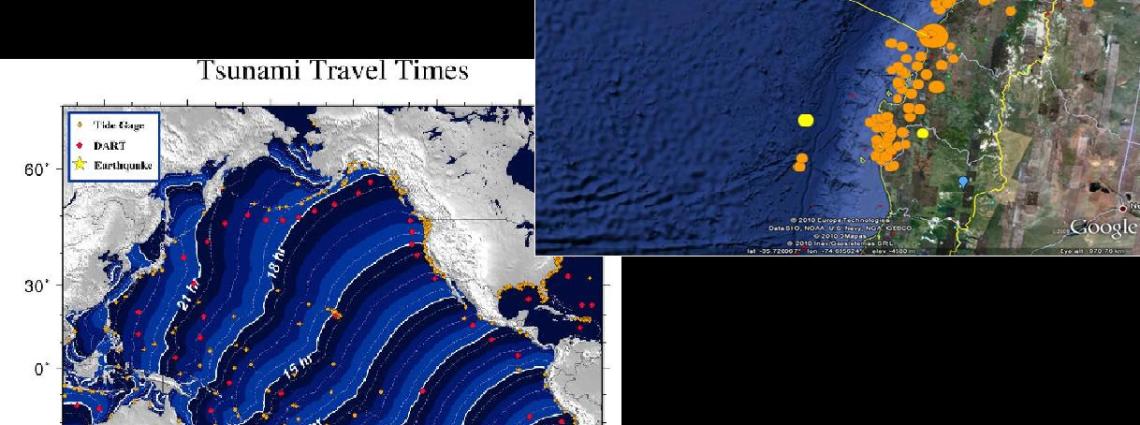Breakthrough in mitigating radioxenon emissions
Vienna, 13 November 2013
As the worldwide production of life-saving medical isotopes increases, so do emissions of the radioactive noble gas xenon. While the emissions in question are not harmful to human health or the environment, they may mask a potential release of this noble gas from an underground nuclear test, thus affecting one of the CTBTO’s key verification technologies.
At the signing ceremony, CTBTO Executive Secretary Lassina Zerbo praised the exemplary corporate responsibility of the medical isotope producers concerned, saying: “I welcome this cooperation with some of the key producers of medical isotopes. It helps us to provide confidence to our Member States that now and in the future, no radioactive release from a nuclear test will go unnoticed.”
The Pledge – Key Points:
The producers will:
- Minimize as far as reasonably practicable isotopic releases so that the monitoring of nuclear tests is minimally impacted.
- Explore means to share their xenon monitoring data with the CTBTO.
- Further support the CTBTO upon request with information regarding radioxenon emissions in order to improve the interpretation or clarification of International Monitoring System (IMS) radioxenon data.
The CTBTO will:
- Assist producers in clarifying any concerns due to elevated IMS readings of radioxenon isotopes.
- Recognize and cooperate with producers who are taking steps to mitigate the effects of emissions on the IMS.
- This collaboration offered by the CTBTO will aim at direct support in expertise, technological development and other possible support.
The four producers that signed the pledge are:
Signing the pledge, Vice President of KAERI, In-Cheol Lim, acknowledged KAERI’s willingness to co-operate with the CTBTO and share information on emission levels. KAERI is an advanced nuclear engineering research company that is planning to open a new facility in the Republic of Korea over the next few years.

CTBTO Executive Secretary Lassina Zerbo (right) signing the pledge with Vice President of KAERI, In-Cheol Lim...
Emmy Hoffmann, ANSTO’s Manager of Nuclear Assurance Services, affirmed ANSTO’s intention to continue its cooperation with the CTBTO. ANSTO has been producing medical isotopes such as molybdenum-99 (Mo-99) for several years and already co-operates with the CTBTO. The pledge was signed in Australia.

with ANSTO’s Manager of Nuclear Assurance Services Emmy Hoffmann...
Yudiutomo Imardjoko Bernadib, President Director of PT Batan Teknologi in Indonesia, signed the pledge to co-operate with the CTBTO in the field of emissions monitoring. An emission monitor has been installed in the production facility stack at Batan Teknologi.

with the President Director of PT Batan Teknologi, Yudiutomo Imardjoko Bernadib...
Carmen Irene Bigles, CEO of Coquí Radio Pharmaceuticals Corp., United States, said: "Coquí’s mission is to secure a U.S. domestic supply of Mo-99 for medical use without the use of HEU in order to guarantee the health of patients and forward the interests of the Global Threat Reduction Initiative. Signing the CTBTO's pledge on radioxenon emissions is in line with Coquí's mission.” Coquí is planning to establish a new production facility over the next few years.

and with Carmen Irene Bigles, CEO of Coquí Radio Pharmaceuticals Corp.
The signing took place during the fourth Workshop on the Signatures of Medical and Industrial Isotope Production (WOSMIP IV) at the CTBTO’s headquarters in Vienna, Austria. The permanent representatives of Belgium, Indonesia, Korea and the United States attended the ceremony. It follows the pledge signed by the Belgian-based Institute for Radioelements (IRE), a major European producer, in June 2013.
Around 70 representatives from established and prospective producers of medical isotopes from 24 countries as diverse as Argentina, Canada, China, Egypt, France, Iran, Jordan, South Africa and the United States, together with experts from CTBTO Member States, and representatives from the International Atomic Energy Agency participated in the three-day workshop. Many of the presentations concentrated on Mo-99 production and the challenges of minimizing radioxenon emissions in this process. The threshold of 5 gigabecquerels per day was identified as the level until which the CTBTO’s monitoring system operates well.
Good practices in the production and radiopharmaceutical separation processes were also under discussion. A number of presentations highlighted the importance of measuring the amount of daily emissions and the value of this information for the CTBTO’s measurements evaluations. The emission data can be used together with atmospheric transport modelling to reveal the effect of releases in the CTBT noble gas samples.
Through its voluntary contributions, the European Union (EU) supports the development of systems that will help producers reduce emissions and the establishment of measuring stations to record and report background levels of radioxenon at different locations around the globe.
Background
The CTBT bans all nuclear explosions by everyone, everywhere: on the Earth’s surface, in the atmosphere, in outer space, underwater and underground. 183 countries have signed the Treaty. Of these, 161 have also ratified the Treaty.
A global verification regime with 337 facilities (final configuration) monitors the globe around the clock for nuclear explosions to detect any violations of the Treaty. After the CTBT has entered into force, on-site inspections can be dispatched to search for evidence of a nuclear explosion on the ground.
The Institute for Radio Elements (IRE) signed the pledge already in June 2013.
Thomas Mützelburg, Public Information Officer
T +43 1 26030 6421
E thomas.muetzelburg@.ctbto.org
M +43 699 1459 6421
